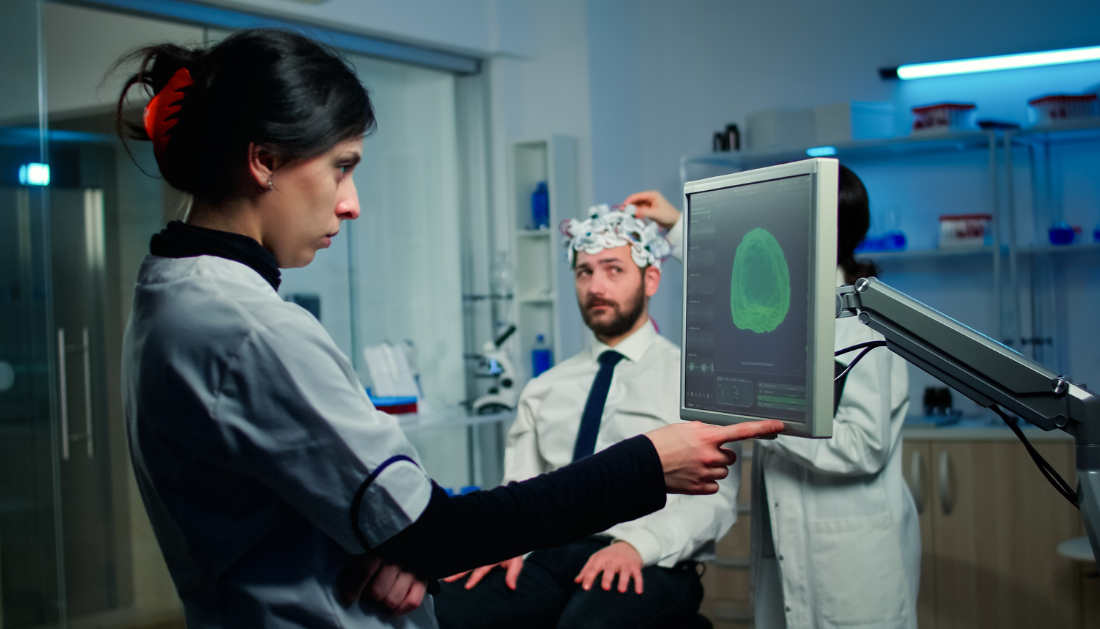

A wearable ultrasonic patch created by engineers at the University of California, San Diego has the potential to provide continuous, non-invasive monitoring of cerebral blood flow. For the first time in wearable technology, the soft, flexible patch may be worn comfortably on the temple to offer three-dimensional data on cerebral blood flow.
The researchers published their novel technology in Nature under the direction of Sheng Xu, a professor in the UC San Diego Jacobs School of Engineering’s Aiiso Yufeng Li Family Department of Chemical and Nano Engineering.
Transcranial Doppler ultrasonography, the current clinical standard, is much inferior to the wearable ultrasound patch. An ultrasound probe must be held against the patient’s head by a qualified technician in order to use this approach. There are drawbacks to the procedure, though. Because it is operator-dependent, the operator’s skill level will determine how accurate the measurement is. Moreover, it is not feasible for continuous usage.
Xu’s group created a tool that gets around these obstacles. Throughout a patient’s hospital stay, their wearable ultrasonography patch provides a hands-free, reliable, and comfortable solution that can be worn continually.
In Xu’s lab, Sai Zhou, a Ph.D. candidate in materials science and engineering, is co-first author of the work. “The continuous monitoring capability of the patch addresses a critical gap in current clinical practices,” Zhou said. Cerebral blood flow is typically measured at specified periods of the day, and such readings may not accurately reflect what occurs during the remainder of the day. Unnoticed variations may occur in between measurements. This gadget may provide information that is essential for prompt intervention if a patient is about to suffer a stroke in the middle of the night.”
According to Geonho Park, a Ph.D. student in Xu’s lab studying chemical and nanoengineering and another co-first author of this work, patients undergoing and recuperating from brain surgery can also benefit from this technique.
The patch is made of silicone elastomer and has multiple layers of flexible electronics embedded in it. It is about the size of a postage stamp. One layer is made up of a collection of tiny piezoelectric transducers that, when electrically activated, generate ultrasonic waves and receive waves that are reflected from the brain. A copper mesh layer consisting of spring-shaped wires is another essential element that improves signal quality by reducing interference from the wearer’s body and surroundings. Elastic electrodes make up the remaining layers.
The patch is wired to a computer and power source in order to function. The researchers included ultrafast ultrasound imaging into the device in order to accomplish 3D monitoring. Ultrafast imaging records thousands of images per second, in contrast to normal ultrasound’s 30 photos per second. Because of the heavy reflection of the skull, the piezoelectric transducers in the patch would ordinarily have poor signal intensity, making this fast frame rate essential for obtaining reliable data.
After that, the data are post-processed using unique algorithms to recreate 3D details like the major arteries of the brain’s size, angle, and location.
“The cerebral vasculature is a multibranched, intricate system of vessels. A second co-first author of this work and a Ph.D. candidate in materials science and engineering at Xu’s group, Xinyi Yang, stated, “To get the full picture and obtain more accurate measurements, you need a device capable of capturing this three-dimensional information.”
The ability of the patch to assess blood flow velocities—peak systolic, mean flow, and end diastolic velocities—in the primary arteries supplying the brain was examined in this study on 36 healthy participants. Participants performed blood-flow-affecting exercises like grasping with their hands, holding their breath, and reading. The measures taken with the patch and a traditional ultrasonography probe agreed quite well.
The patch will then be tested on individuals with neurological disorders that affect cerebral blood flow by the researchers in partnership with medical professionals at UC San Diego School of Medicine. Xu is a co-founder of Softsonics, a startup firm aimed at commercializing this technology.
For more information: Transcranial volumetric imaging using a conformal ultrasound patch, Nature, https://dx.doi.org/10.1038/s41586-024-07381-5
more recommended stories
 T-bet and the Genetic Control of Memory B Cell Differentiation
T-bet and the Genetic Control of Memory B Cell DifferentiationIn a major advancement in immunology,.
 Parkinson’s Disease Care Advances with Weekly Injectable
Parkinson’s Disease Care Advances with Weekly InjectableA new weekly injectable formulation of.
 Brain’s Biological Age Emerges as Key Health Risk Indicator
Brain’s Biological Age Emerges as Key Health Risk IndicatorClinical Significance of Brain Age in.
 Children’s Health in the United States is Declining!
Children’s Health in the United States is Declining!Summary: A comprehensive analysis of U.S..
 New Blood Cancer Model Unveils Drug Resistance
New Blood Cancer Model Unveils Drug ResistanceNew Lab Model Reveals Gene Mutation.
 Emotional Processing for Chronic Pain Relief
Emotional Processing for Chronic Pain ReliefA groundbreaking clinical trial led by.
 Egg White Proteins for Hypertension
Egg White Proteins for HypertensionEgg white proteins for hypertension have.
 Limited Health Care Access During Disasters Delays Colorectal Cancer Diagnoses
Limited Health Care Access During Disasters Delays Colorectal Cancer DiagnosesNatural disasters like Hurricanes Irma and.
 Ethical Issues in Human-AI Relationships
Ethical Issues in Human-AI RelationshipsAs artificial intelligence becomes increasingly lifelike.
 Osteoarthritis Genetics Study Uncovers New Treatment Hope
Osteoarthritis Genetics Study Uncovers New Treatment HopeOsteoarthritis- the world’s leading cause of.

Leave a Comment